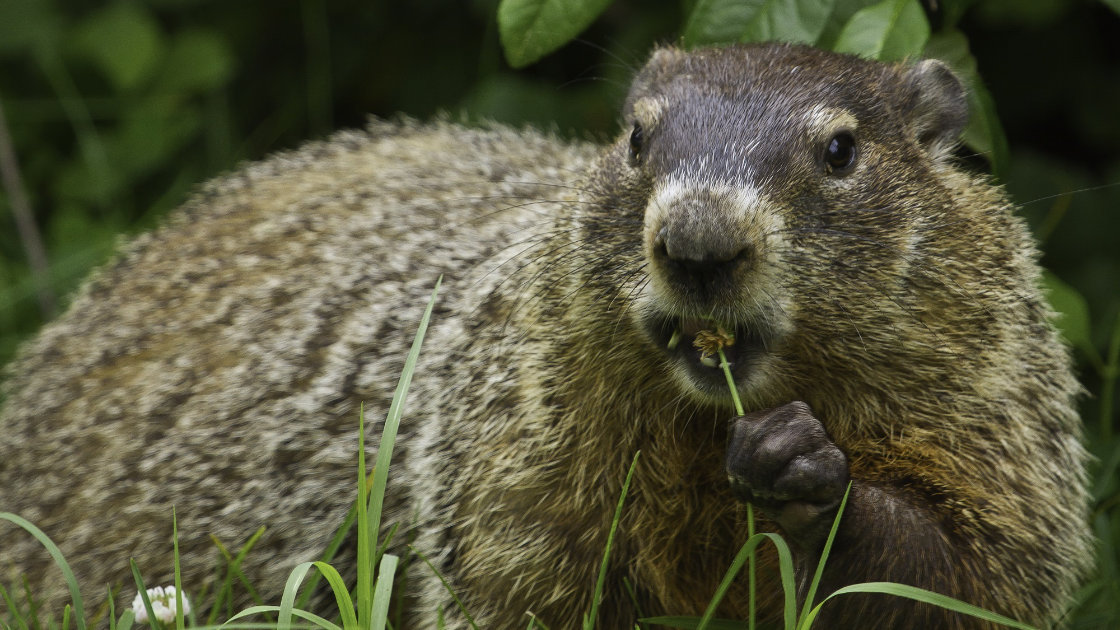Hello Folks,
Aunt Eunice here today with some information on groundhogs, otherwise known as woodchucks. With Groundhog Day just around the corner I want to share some facts about the largest member of the ground squirrel family.
Physical Characteristics
It may surprise you to know that a groundhog can grow to 24 inches and weigh up to 13lbs. Like other squirrels, groundhogs have long tails that grow around 7 inches long. According to the National Wildlife Federation, during the warm months, a groundhog’s incisors grow about a sixteenth of an inch each week to keep up with their frenzied eating schedule.
Habitat, Hibernation, Conflict with Farmers
Also, according to the NWF groundhogs are found only in North America, from Canada down to the southern United States. They like woodland areas that bump up against more open areas. They dig burrows that can be 6 feet deep, and 20 feet wide. These underground homes can have two to a dozen entrances. All those entrances are why the groundhog is not a farmer’s best friend. The holes can break farm equipment or twist a leg. Worst of all, since groundhogs have a hefty appetite as they load up for winter hibernation, a farmer’s garden and crops make for an abundant (and tasty) food source. They can eat about a pound of food per sitting. While hibernating, the groundhog’s heartbeat slows from 80 beats per minute to 5 beat per minute; their respiration reduces from 16 breaths per minute to as few as 2 breaths per minute; and their body temperature drops from about 99 degrees Fahrenheit to as low as 37 degrees.
Groundhog Behavior & Capabilities
The NWF says groundhogs are solitary creatures, living about six to eight years. They eat vegetables and fruits, whistle when they’re frightened or looking for a mate (they’re sometimes called whistle pigs) and can climb trees and swim. In February, male groundhogs emerge from their burrows to look for a mate (not to predict the weather) before going underground again. They come out of hibernation for good in March.
Why is it Also Called a Woodchuck?
In Quiet Valley’s one room school “students” are required to do tongue twisters as part of their school day. One of them is, How much wood would a woodchuck chuck, if a woodchuck could chuck wood? According to Cornell University it would be about 700 lbs. Actually, the name woodchuck has nothing to do with wood, or chucking it, according to the Animal Diversity Web. The word woodchuck comes from a Native American word, wuchak, which roughly translates as “digger.” Nevertheless, according to Cornell, a wildlife biologist sought to answer the tongue-twister’s question. He measured the volume of a woodchuck burrow and estimated that if the hole were filled with wood rather than dirt, the woodchuck would have chucked about 700 lbs. (Woodchucks, however, typically do not chew wood.)
First Groundhog Day
According to History.com – On February 2, 1887, Groundhog Day, featuring a rodent meteorologist, was celebrated for the first time at Gobbler’s Knob in Punxsutawney, Pennsylvania. According to tradition, if a groundhog comes out of its hole on this day and sees its shadow, it gets scared and runs back into its burrow, predicting six more weeks of winter weather; no shadow means an early spring.
Groundhog Day has its roots in the ancient Christian tradition of Candlemas, when clergy would bless and distribute candles needed for winter. The candles represented how long and cold the winter would be. Germans expanded on this concept by selecting an animal–the hedgehog–as a means of predicting weather. Once they came to America, German settlers in Pennsylvania continued the tradition, although they switched from hedgehogs to groundhogs, which were plentiful in the Keystone State.
In 1887, a newspaper editor belonging to a group of groundhog hunters from Punxsutawney called the Punxsutawney Groundhog Club declared that Phil, the Punxsutawney groundhog, was America’s only true weather-forecasting groundhog. The line of groundhogs that have since been known as Phil might be America’s most famous groundhogs, but other towns across North America now have their own weather-predicting rodents, from Birmingham Bill to Staten Island Chuck to Shubenacadie Sam in Canada.
That’s all for now. Thanks for checking in and here’s hoping the groundhog doesn’t see his shadow! My old bones would appreciate an early spring. Take care. Aunt Eunice
